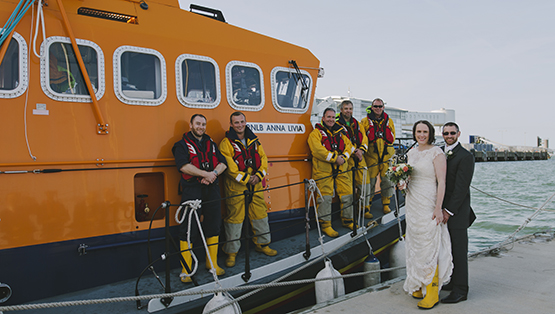Volunteer lifeboat crew with Dun Laoghaire RNLI, Rory Bolton and Dr. Sarah Brookes, set sail on a new life together after tying the knot this weekend. The couple shared the big day with family and friends and their eighteen-month old daughter Alice before being brought in style to their reception on board the Dun Laoghaire RNLI lifeboat.
Love blossomed for the couple after senior lifeboat helm Rory left Lifeboat Medical Advisor Sarah out of a crew training email and she let him know she was not impressed. He responded by sending her a very special invite to station training and a quick coffee after the exercise saw the pair eventually falling for each other. Rory popped the question over a game of scrabble, spelling out the words asking Sarah to be his bride and the rest is history.
Sarah was no stranger to the RNLI when she volunteered for the lifeboat in 2009. Her late father Dr. Donald Brookes was the station’s previous Lifeboat Medical Advisor, a volunteer position that looks after the lifeboat crew’s medicals and can also offer medical assistance on a lifeboat callout. Rory is the senior helm on the inshore lifeboat and the third mechanic at the station, he has volunteered with the life-saving charity since 2000.
Since the couple have had their beautiful daughter Alice, Sarah has stepped back from her role on the lifeboat but still carries out her medical duties for the station. The big day would not have been complete without a lifeboat connection and the couple arrived to their reception on board the all-weather lifeboat courtesy of their colleagues with Dun Laoghaire RNLI.
Commenting on the day the proud groom Rory Bolton said, ‘Thankfully there wasn’t a lifeboat callout at the time or we would have had to keep our guests waiting while we went to help. Both Sarah and I love volunteering for the RNLI and of course it’s even more special now as it’s how we met.’
Dun Laoghaire RNLI Lifeboat Operations Manager Stephen Wynne added, ‘On behalf of everyone at Dun Laoghaire RNLI we would like to wish Rory and Sarah a long and happy life together. They are both fantastic volunteers and I’m delighted that it was our lifeboat station that brought them together.’
The lifeboat involvement did not stop there however, as Dun Laoghaire RNLI received a callout later that night while the reception was in full swing. Groom Rory left his new wife’s side to race down to the lifeboat station metres away but Coxswain Mark McGibney sent him straight back as he had a full crew complement and felt that Rory deserved his wedding night off-call.































































